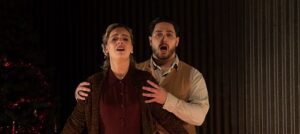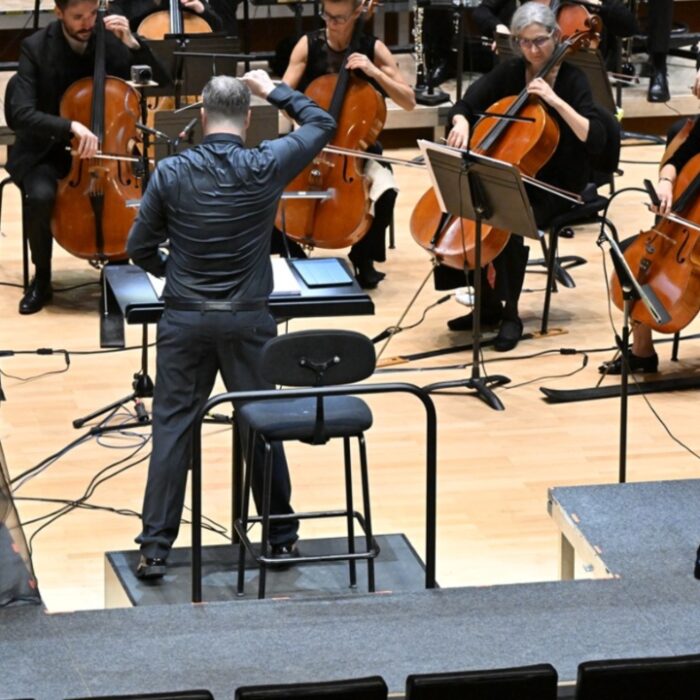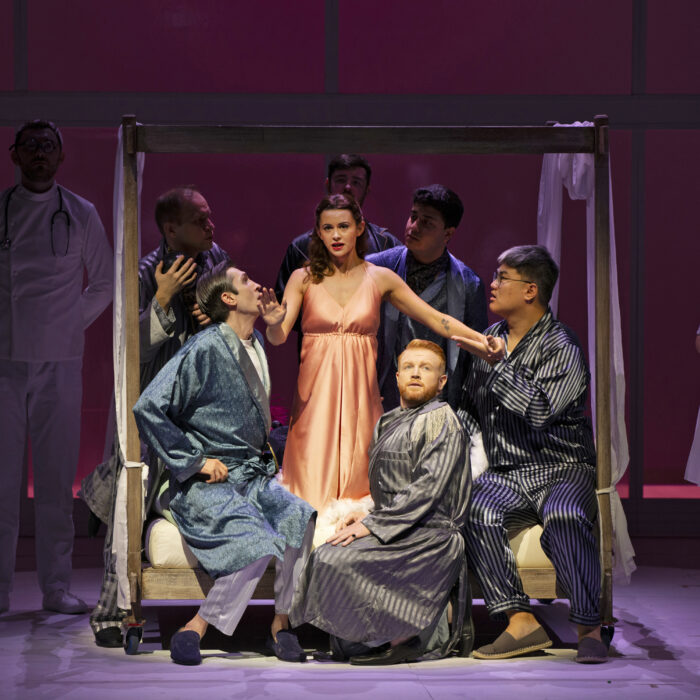
Irish National Opera 2022-23 Review: Werther
Italian Tenor Cataldo Makes A Big Splash In Title Role
By Alan Neilson(Photo: Pat Redmond)
The 1950s saw the rollout of electricity across rural Ireland, a process that significantly changed not just the countryside but also the lives of its people. Electrical appliances such as kettles, cookers, hairdryers and lighting meant that life in many ways became more comfortable and freed up time for leisure activities. Moreover, it impacted traditional roles and experiences of rural people. Women, the traditional homemakers, now found greater freedom to pursue other interests as household chores became less time consuming. The people’s values and attitudes were, however, much slower to change. Anyone bold enough to step too far from the accepted codes of behavior would soon find themselves challenged. Young men who decided to engage with the emotional and artistic side of their nature risked ridicule or worse.
This was the context that the director Sophie Motley decided upon for her presentation of Irish National Opera’s production of Massenet’s “Werther.”
Werther In An Irish Setting
It was a bold call by Motley; the idea of centering the drama against the background of electrification in a rural community may sound rather strange, and removing the drama from the context of 18th or 19th century bourgeois society may appear to be sidestepping one of the fundamental drivers of the work. Yet, it worked splendidly in bringing out the societal pressures and conflicts that make Werther and Charlotte’s love untenable and which ultimately lead to Werther taking his own life.
Charlotte is the daughter of a bailiff and thus a step apart from the rural community in which she lives. She is, in effect, a member of the petit-bourgeoise. She has a little more financial security than most of her neighbors and can afford a better lifestyle, but she is bound by the rigid, conservative values of her class, which are reinforced by the heavy traditions of a static rural society. She has also found herself in tight circumstances from which she cannot escape; not only has she had to take on the responsibilities of looking after her now orphaned siblings, but she also promised her dying mother that she would marry the staid, middle class Alfred, neither of which she can ignore. Therefore, when the passionate and rebellious Werther appears on the scene and awakens feelings in her that have hitherto laid dormant, she is forced to suppress them. After all, this is 1950s rural Ireland, where women’s roles were strictly defined and expectations and pressures to conform were strong. This is the point at which the story could have ended, but the introduction of electricity changes everything.
Having done the right thing and married Alfred, Charlotte is now responsible for looking after her new home, but with Alfred often away, without children to look after and with the help of recently installed electricity she has plenty of free time to read and re-read Werther’s letters and to muse and reflect on her feelings for him. The gateway to Werther’s tragedy has now been opened.
Motley was aided in her staging by costume and set designer Sarah Bacon and lighting designer Sarah Jane Shiels. The costumes relied on standard 1950s designs that clearly drew attention to the characters’ social position, so that Albert was always neatly dressed in semi-formal attire, which made him look fairly dull and conformist; Werther was more flamboyantly costumed to suggest his non-conformist attitude; and Charlotte was fashionable, smart, clean and presentable to reveal that she had access to money and was of good standing.
It would not be unfair to suggest that Irish National Opera productions tend to be conservative with regard to the amount of money they spend on sets. On a scale, with lavish at one end and minimalist at the other, the productions usually lean towards the minimalist end of the scale, and this was certainly the case with their production of “Werther.” Nevertheless, and notwithstanding this fact, Bacon’s designs were successful in developing and promoting the drama. In Act two, set in the church hall, the community celebrates its connection to the electricity grid, and although the staging was simple, it was cleverly and amusingly staged. There was bunting and a large banner across the stage, as well as a table with electrical items to be won. The final act was little more than a bare set, representing an empty field upon which Charlotte comforts the dying Werther as the snow falls. It worked superbly in creating the intimacy and isolation into which the two lovers have been thrust.
Motley’s management of the scenes was excellent throughout. The relationships between all the characters were clearly depicted, and her use of the small stage and small cast created lively, crowded and energetic scenes, such as that in the church hall, which she successfully contrasted with more intimate scenes in which Werther and Charlotte were alone. Her character portrayals were convincingly developed, which brought depth to the presentation and allowed Charlotte’s bourgeois values, supported by the traditional values of the community, to collide with Werther’s romantic sense of freedom, and his rejection, of commonly held attitudes, and to cause Charlotte’s own inner torment.
It was also a production that highlighted Charlotte’s own tragedy in having to marry a man she does not love simply to satisfy the community and, to an extent, her own prejudices. Something that is not at all uncommon in close communities the world over, let alone 1950s rural Ireland. Moreover, Motley’s treatment of Werther successfully brought out his isolation, alienated from the community by his romantic sensitivities and brooding personality. A young man in 1950s rural Ireland who did not conform to the traditional masculine role, who looked to the arts, and who cultivated his romantic nature would have been unlikely to find much sympathy, and was destined to remain an outsider.
As a touring production playing in theaters of varying sizes across Ireland, some of which are quite small, it was inevitable that the orchestra would have to be reduced in size. Philipp Pointer, conducting the Irish National Opera Orchestra, produced a wonderful rendition of Richard Peirson’s new arrangement of the score for just 12 musicians. Not only was he able to generate sufficient strength and depth from the orchestra to convey the dramatic nuances of the piece, but Peirson’s impressive arrangement allowed for a wide inventive array of textures in what was a clear and clean-sounding performance.
O’Sullivan Leads An Excellent Cast
Mezzo-soprano Niamh O’Sullivan produced a compelling performance in the role of Charlotte, with a powerful presentation that plumbed the depths of her emotional being. Over the course of the evening, the audience watched on as the initially responsible and morally correct young woman was torn apart by her conflicted feelings and a love she ultimately could not control. It was a believable, intelligent and subtle characterization, one in which Charlotte was allowed to develop naturally in response to the pressures around her.
O’Sullivan possesses a fascinating voice that is able to draw in the listener. She has a rich, colorful palette, a natural, easy lyricism, a warm lower register with depth, and her phrasing is beautifully crafted, which gives her singing a refined air. The role of Charlotte, however, also requires a dramatic dimension, and she did not disappoint. Engaging fully with Charlotte’s changing and conflicted feelings, she coated the voice in a variety of emotions, employing a wide range of colors and dynamic accents, and pushed confidently into her upper register as her passions rose. She was loving, confused, frustrated, angry and, at times, fiery. The emotions tumbled forth, and they did so with a suitable electric frisson, yet her voice was always secure and controlled.
The young Italian tenor, Paride Cataldo, who was cast in the title role, immediately caught the attention with his distinctive, rich, lyrical singing. He possesses a voice that positively oozes passion, and his ability to spin out long, inviting lines and push the voice upwards with strength and ease is captivating. Unsurprisingly, he made an ardent, fervent Werther; his voice alone ensured this much. Each aria was beautifully delivered and the scenes with O’Sullivan, particularly in the final act, were spellbinding; the two voices combined exquisitely, both were expressively strong, both infused their lines with passion and energy, and both created the necessary tension to bring the scene fully alive.
Although, only at the start of his career, he has already made his debut at La Scala, albeit in a small role, but be assured you will be hearing more of Cataldo in the future.
Baritone Charles Rice was a particularly dislikable Albert. As a typical bourgeois, he was suitably well-mannered and correct, but his superficiality was obvious. On realizing that Werther was going to kill himself, he could barely conceal his joy; he would not have wanted to deal with the problem directly. His singing was nicely crafted to meet his situation. Initially, he sounded somewhat bland, which successfully gave the impression that his true emotions were being suppressed. As the drama progressed, however, and his passions started to break through, there were injections of emotion.
Sophie, Charlotte’s younger sister, was played by soprano Sarah Shine. Although not a large role, it does have the potential to showcase the qualities of a young singer, and Shine took full advantage by producing a clearly defined reading that displayed her clear, bright upper register, vocal flexibility and expressivity to good effect.
Baritone Wyn Pencarreg cut a fine, upstanding figure as the Bailiff, who was neatly integrated into the community, highlighting the context in which Charlotte lived and drawing further attention to Werther’s isolation. He has a warm, appealing timbre and sang with clarity and confidence.
The roles of Schmidt and Johann were parted by tenor Eamonn Mulhall and baritone Owen Gilhooly-Miles. Both gave solid performances as workers for the electricity company. Presumably, they were recent arrivals in the village and will soon leave. The fact that they so easily slipped into the life of the community, once again, drew attention to Werther’s isolation.
The idea of setting the opera in 1950s rural Ireland, despite sounding somewhat contrived, actually worked very well in developing the work’s themes and did a fine job in uncovering the societal pressures to which Charlotte is subjected. Ultimately, this was a splendid musical performance from all involved.
The review is of the performance at Dundalk’s An Táin theatre.



